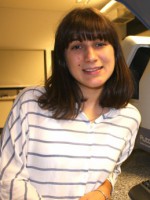resumo
Luminescent solar concentrators (LSCs) are luminescent waveguide layers that convert sunlight into specific wavelengths which are then guided by total internal reflection to a PV device located at the edges of the LSC. Their ability to concentrate sunlight onto small areas makes LSCs a useful complement to silicon-based PVs in a series of applications, such as urban integration and flexible fabrics towards mobile solar-energy. Challenges for the luminescent layer include the use of low-cost and sustainable nature-based organic molecules. We report novel chlorophyll-based LSCs with emission properties in the red/NIR spectral region. Here, chlorophyll molecules extracted from Spirulina maxima, an abundant cyanobacterium and an attractive natural source, are immobilized in organic-inorganic di-and tri-ureasil matrices enabling the production of sustainable LSCs. At low chlorophyll concentrations (<3 x 10(17) molecules per cm(3)), the photophysical properties of the chlorophyll molecules after incorporation into the hybrids closely resemble those in ethanolic solution (with an absolute emission quantum yield of similar to 0.16 and a fluorescence lifetime of similar to 8 ns). The LSCs were coupled to a Si-based commercial PV device revealing optical conversion efficiency and power conversion efficiency values of similar to 3.70% and 0.10%, respectively, illustrating the potential of this approach for the development of nature-based LSCs meeting the requirements of reliable, sustainable and competitive energy systems.
palavras-chave
CELL EFFICIENCY; ENERGY-TRANSFER; FLUORESCENCE; SPECTRA; CONVERSION; EMISSION; RED; BRIGHTNESS; ABSORPTION; PHOSPHORS
categoria
Chemistry; Energy & Fuels; Materials Science
autores
Frias, AR; Pecoraro, E; Correia, SFH; Minas, LMG; Bastos, AR; Garcia-Revilla, S; Balda, R; Ribeiro, SJL; Andre, PS; Carlos, LD; Ferreira, RAS
nossos autores
Projectos
Harvesting the energy of the sun for a sustainable future (CENTRO-07-ST24-FEDER-002032)
CICECO - Aveiro Institute of Materials (UID/CTM/50011/2013)
SusPhotoSolutions - Soluções Fotovoltaicas Sustentáveis (SUSPHOTOSOLUTIONS)
agradecimentos
Funding was provided by Fundacao para a Ciencia e a Tecnologia (FCT), EU/FEDER COMPETE and Mais Centro-PORC, under contracts PEST-OE/EEI/LA0008/2013 and CENTRO-07-ST24-FEDER-002032. This work was developed within the scope of the projects CICECO-Aveiro Institute of Materials, POCI-01-0145-FEDER-007679 (FCT Ref. UID/CTM/50011/2013), SusPhotoSolutions - Solucoes Fotovoltaicas Sustentaveis, CENTRO-01-0145-FEDER-000005 and Instituto de Telecomunicacoes (FCT Ref. UID/EEA/50008/2013), financed by national funds through the FCT/MEC and when appropriate co-financed by FEDER under the PT2020 Partnership Agreement. SFHC thanks SusPhotoSolutions for the post-doctoral grant and ARF and ARB acknowledge FCT for their PhD grants (PD/BD/114454/2016 and PD/BD/105859/2014). LDC is grateful to CAPES and CNPq (Brazil) for a fellowship within the science without borders program. SJLR acknowledges funding agency FAPESP and the Brazilian network on Photonics INFO (Instituto Nacional de Fotonica).






